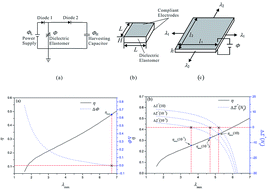Investigation on the performance of a viscoelastic dielectric elastomer membrane generator
Abstract
Dielectric elastomer generators (DEGs), as a recent transduction technology, harvest electrical energy by scavenging mechanical energy from diverse sources. Their performance is affected by various material properties and failure modes of the dielectric elastomers. This work presents a theoretical analysis on the performance of a dielectric elastomer membrane generator under equi-biaxial loading conditions. By comparing our simulation results with the experimental observations existing in the literature, this work considers the fatigue life of DE-based devices under cyclic loading for the first time. From the simulation results, it is concluded that the efficiency of the DEG can be improved by raising the deforming rate and the prescribed maximum stretch ratio, and applying an appropriate bias voltage. However, the fatigue life expectancy compromises the efficiency improvement of the DEG. With the consideration of the fatigue life, applying an appropriate bias voltage appears to be a more desirable way to improve the DEG performance. The general framework developed in this work is expected to provide an increased understanding on the energy harvesting mechanisms of the DEGs and benefit their optimal design.


 Please wait while we load your content...
Please wait while we load your content...